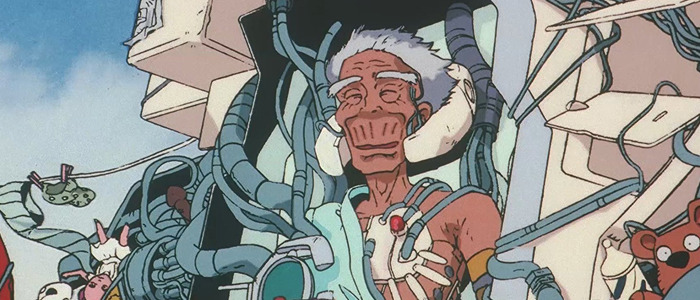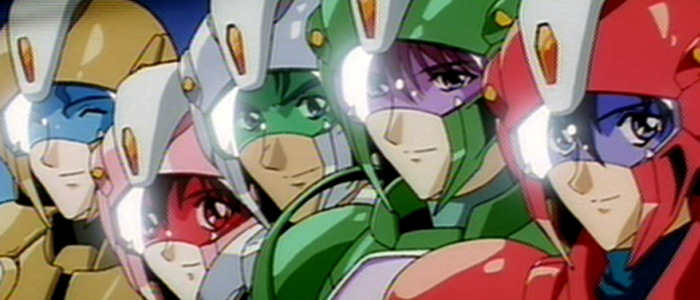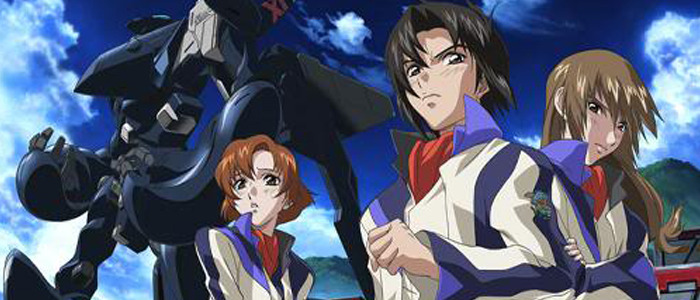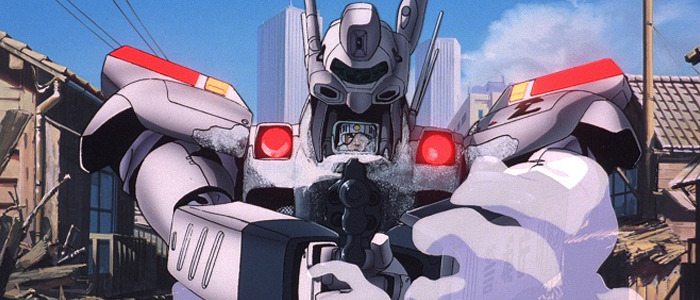Here's The Anime You Should Watch After 'Pacific Rim Uprising'
From the beginning, Pacific Rim has been a franchise built on the hopes and dreams of Japanese Animation and pop culture fanatics. Filled with tributes and references to anime, director Guillermo del Toro took his passion for Gundam and Kaiju films and smashed it all together into an explosion of ridiculous antics, one-liner friendly characters, and tons of pure popcorn fun. And with the new installment in the series, Steven S. DeKnight's Pacific Rim Uprising, the love for celebrating the legacy of Otaku friendly titles hasn't stopped in the slightest.
It's time for a quick crash course on some anime you should check out after seeing the new movie. If you dug what you saw on the big screen, these will not disappoint.
Roujin Z
To get you in the mood for giant pieces of technology over which humanity loses control, let me introduce you to the cult classic Roujin Z. Written by Akira's Katsuhiro Otomo, this film's plot reflects the sad reality of elderly healthcare in the world (especially in Japan), where the youth would much rather focus on themselves than help their elders live out the rest of their lives peacefully. And with Otomo's usual bits of creepy-but-all-too-real storytelling, this comedy remains one of the strangest yet oddly mature pieces that the anime legend ever worked on.
Taking place in 21st century Japan, the Ministry of Public Welfare has created a machine, known as the Z-001. This computerized hospital bed turned mecha nurse of your futuristic dreams (or nightmares) can take complete care of any patient, including the dispensing of food and medicine, the removal of bodily waste, and other physical care within its structural frame. All of these features are displayed to the public on the "volunteer" widower, Kiyuro Takazawa, as his original nurse (the medical student, Haruko) watches with doubt in her eyes.
And though this machine seems well intentioned by those on the outside, it becomes quite clear to Haruko that Kiyuro doesn't feel safe and is in need of a "human touch." Through various circumstances (including the involvement of 90-year-old computer hackers), the Z-001 takes on the intentions and voice of Kiyuro's late wife. And from there, the insanity begins.
Special Duty Combat Unit Shinesman
With only two OVA (Original Video Animation) episodes, Special Duty Combat Unit Shinesman has remained an anime cult classic to anyone looking for a parody that gets Super Sentai (super task force) shows, while also remaining a loving tribute to the genre. It hasn't lost its wit or quality even some 22 years later.
Based on the manga by Kaimu Tachibana and Hideki Sonoda, Shinesman tells of a war of "Big Business," where the evil villain "Voice" plans to create a corporation that will be powerful enough to conquer the entire planet. Thankfully, Earth has an ultimate "weapon": the Special Duty Combat Unit Shinesman, a group of adults fighting crime in the form of the Tokusatsu shows they watched as kids, but with a businessman flare. Now, its up to Shinesman Red, Shinesman Sepia, Shinesman Moss Green, Shinesman Salmon Pink, and Shinesman Gray with their "Business Card Cutters" and "Tie Clip Bombs" to save the day!
Shinesman always has a special place in my heart. This OVA knows what it is, embraces its ridiculousness, and never takes itself too seriously. The humor and visual nods offer a wink to an audience who knows their anime and pop culture well enough to laugh at the jokes, and appreciate the absurdity of the story.
Fafner: Dead Aggressor
Back in the mid-2000s, Hisashi Hirai was the guy to do character designs for your teen angst-filled Mecha series, and Fafner: Dead Aggressor was one of the best he ever worked on. Directed by Nobuyoshi Habara (D.N. Angel), with an opening theme by rock group Angela, and Mecha designs by Naohiro Washio (Mobile Suit Gundam 00), this 26 episode series still remains one heck of a beautifully animated ride.
The story of the series takes place on the island Tatsumiyajima, which has been hidden away from the world via an advanced cloaking shield. The heroes of the series (Kazuki, Soushi and Maya) live very normal lives, until a Festum (an alien race that had wiped out the majority of Japan, Borg-style) breaks through the protective shield, creating chaos in its wake – a problem that not even the adults can solve. But when it is discovered that a kind of giant robot (the Fafner) can be the greatest defense against these aliens, and that only children can pilot them, Kazuki and his friends' lives change forever.
Fafner: Dead Aggressor is a slow burn that, as the series progresses, becomes a compelling mystery. With the spooky villains and these kids that have to grow up all too quickly to save their home, Fafner dives a bit deeper in the questions that the original Mobile Suit Gundam asked audiences about war, while still not going full-Evangelion in its emotional intensity. And since Pacific Rim Uprising features similarly young pilots dealing with their battle against aliens that adults can't take on, Fafner is a great (though more serious) take on this kind of a story.
Patlabor
With a young spunky girl as the protagonist of its franchise (much like Pacific Rim Uprising's own Amara Namani), Patlabor remains an anime classic (in all of its various forms) to this day. Look to its unapologetic storytelling, incredible characters, and how it jumpstarted the careers of so many icons of the Japanese Animation industry, including Mamoru Oshii (Ghost in the Shell), Akemi Takada (Urusei Yatsura), and Kazunori Ito (.hack//Sign).
Though the TV series, OVAs and animated films all tell different individual stories, the general plot of the Patlabor franchise remains the same. In the "near future" of 1998 through 2002, robots called Labors are employed to help society with tasks such as construction work, along with aiding the Tokyo Metropolitan Police in their missions in the form of Patrol Labors (AKA Patlabors.) And in Special Vehicle Section 2, Division 2, the franchise's main protagonist Noa Izumi pilots one of these robots. This is where the franchise spends most of its time, and brings to life the insane hijinks and drama of Noa and her police friends.
Patlabor stands as a symbol of an anime time gone by, when the focus was on slightly more optimistic sci-fi stories that were a product of the 80s, before "moe" characters had yet to truly take over the entire anime market. And with the disinterest in the live action adaptation of Patlabor from 2011, it shows how much the anime crowd has truly changed. But hopefully, with the growing interest in giant robot stories coming around again, Patlabor can make its glorious and proper animated return to the world and inspire fans and filmmakers as it did 30-plus years ago.




